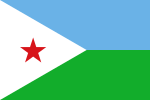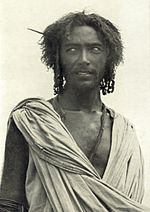Culture of Djibouti
 |
| Part of a series on the |
| Culture of Djibouti |
|---|
| Culture |
|
People |
|
Religion |
| Language |
| Politics |
|
|
The culture of the Republic of Djibouti is diverse, due to the nation's Red Sea location at a crossroads of trade and commerce.
Djiboutian population is divided into several human components: the
The
Ethnic groups
Djibouti is a
Arabs
Djiboutians have had expansive relations with the
Somali
Somalis have traditionally been organized into nomadic pastoral clans, loose empires, sultanates and city-states.[7]
Their clan groupings are important
Afar
Afar society has historically been organized into independent kingdoms, each ruled by its own Sultan.[9] A portion of the community also consists of pastoralists, raising goats, sheep, and cattle in the desert.[9]
Socially, they are organized into clan families and two main classes: the asaimara ('reds') who are the dominant class politically, and the adoimara ('whites') who are a working class and are found in the Mabla Mountains.[10]
In addition, the Afar are reputed for their martial prowess. Men traditionally sport the jile, a famous curved knife. They also have an extensive repertoire of battle songs.[9]
Languages

Djibouti is a
Religion
With few exceptions,
Attire

When not dressed in western clothing such as
Women typically wear the dirac, which is a long, light, diaphanous voile dress made of cotton or polyester that is worn over a full-length half-slip and a bra. Married women tend to sport head-scarves referred to as shash, and also often cover their upper body with a shawl known as garbasaar. Unmarried or young women, however, do not always cover their heads. Traditional Arabian garb such as the male jellabiya (jellabiyaad in Somali) and the female jilbāb is also commonly worn. For some occasions such as festivals, women may adorn themselves with specialized jewelry and head-dresses similar to those worn by the Berber tribes of the Maghreb.[citation needed]
Music
Djibouti's various ethnic groups each have their own different styles of music and accompanying dances. Common instruments used by many of the communities are the drum,
Sport
Football is the most popular sport in Djibouti. The Djibouti national football team, nicknamed the Riverains de la Mer Rouge ("Shoremen of the Red Sea"), plays various international squads both locally and abroad. It is controlled by the Djiboutian Football Federation, and is a member of the Confederation of African Football (CAF) and the Union of Arab Football Associations (UAFA). There are also hundreds of football clubs that compete at the domestic level.[citation needed]
See also
Notes
- ^ a b Djibouti. CIA World Factbook
- ^ "Djibouti". The World Factbook. CIA. February 5, 2013.
- ^ 1985 International Symposium on Geothermal Energy, Volume 9, Part 1, p 175
- ^ A Political Chronology of Africa - Page 131, David Lea, Annamarie Rowe - 2001
- ^ African Business - Issues 338-348 - Page 376, 2008
- ^ "Kingdom donates SR50m for Yemeni refugees in Djibouti". 15 October 2015.
- ^ Mohamed Diriye Abdullahi, Cultures and Customs of Somalia, (Greenwood Press: 2001), p. 138.
- ^ Ioan M. Lewis, Blood and Bone: The Call of Kinship in Somali Society, (Red Sea Press: 1994), p.51
- ^ a b c Matt Phillips, Jean-Bernard Carillet, Lonely Planet Ethiopia and Eritrea, (Lonely Planet: 2006), p.301.
- ISBN 978-3-447-04746-3. Retrieved 30 May 2011.
- ^ Ethnologue, "Languages of Djibouti"
- ISBN 0-14-014423-4
- ^ Mohamed Diriye Abdullahi, Culture and Customs of Somalia, (Greenwood Press: 2001), p.1
- ^ Diriye, pp.170-171


